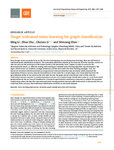Target Unbiased Meta-Learning for Graph Classification
| dc.contributor.author | Ming, L | |
| dc.contributor.author | Shuo, Z | |
| dc.contributor.author | Chunxu, L | |
| dc.contributor.author | Wencang, Z | |
| dc.date.accessioned | 2021-09-16T16:08:53Z | |
| dc.date.available | 2021-09-16T16:08:53Z | |
| dc.date.issued | 2021-10 | |
| dc.identifier.issn | 2288-4300 | |
| dc.identifier.issn | 2288-5048 | |
| dc.identifier.uri | http://hdl.handle.net/10026.1/17810 | |
| dc.description.abstract |
Even though numerous works focus on the few-shot learning issue by combining meta-learning, there are still limits to traditional graph classification problems. The antecedent algorithms directly extract features from the samples, and do not take into account the preference of the trained model to the previously “seen” targets. In order to overcome the aforementioned issues, an effective strategy with training an unbiased meta-learning algorithm was developed in this paper, which sorted out problems of target preference and few-shot under the meta-learning paradigm. First, the interactive attention extraction module as a supplement to feature extraction was employed, which improved the separability of feature vectors, reduced the preference of the model for a certain target, and remarkably improved the generalization ability of the model on the new task. Second, the graph neural network was used to fully mine the relationship between samples to constitute graph structures and complete image classification tasks at a node level, which greatly enhanced the accuracy of classification. A series of experimental studies were conducted to validate the proposed methodology, where the few-shot and semisupervised learning problem has been effectively solved. It also proved that our model has better accuracy than traditional classification methods on real-world datasets. | |
| dc.format.extent | 1355-1366 | |
| dc.language | en | |
| dc.language.iso | en | |
| dc.publisher | Elsevier | |
| dc.subject | meta-learning | |
| dc.subject | graph neural networks | |
| dc.subject | graph classification | |
| dc.subject | few-shot learning | |
| dc.title | Target Unbiased Meta-Learning for Graph Classification | |
| dc.type | journal-article | |
| dc.type | Journal Article | |
| plymouth.author-url | https://www.webofscience.com/api/gateway?GWVersion=2&SrcApp=PARTNER_APP&SrcAuth=LinksAMR&KeyUT=WOS:000753588200003&DestLinkType=FullRecord&DestApp=ALL_WOS&UsrCustomerID=11bb513d99f797142bcfeffcc58ea008 | |
| plymouth.issue | 5 | |
| plymouth.volume | 8 | |
| plymouth.publication-status | Published | |
| plymouth.journal | Journal of Computational Design and Engineering | |
| dc.identifier.doi | 10.1093/jcde/qwab050 | |
| plymouth.organisational-group | /Plymouth | |
| plymouth.organisational-group | /Plymouth/Faculty of Science and Engineering | |
| plymouth.organisational-group | /Plymouth/Faculty of Science and Engineering/School of Engineering, Computing and Mathematics | |
| plymouth.organisational-group | /Plymouth/REF 2021 Researchers by UoA | |
| plymouth.organisational-group | /Plymouth/REF 2021 Researchers by UoA/UoA11 Computer Science and Informatics | |
| plymouth.organisational-group | /Plymouth/Users by role | |
| plymouth.organisational-group | /Plymouth/Users by role/Academics | |
| dcterms.dateAccepted | 2021-07-16 | |
| dc.rights.embargodate | 2021-9-18 | |
| dc.identifier.eissn | 2288-5048 | |
| dc.rights.embargoperiod | Not known | |
| rioxxterms.versionofrecord | 10.1093/jcde/qwab050 | |
| rioxxterms.licenseref.uri | http://www.rioxx.net/licenses/all-rights-reserved | |
| rioxxterms.licenseref.startdate | 2021-10 | |
| rioxxterms.type | Journal Article/Review |


